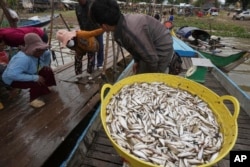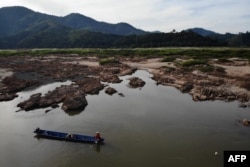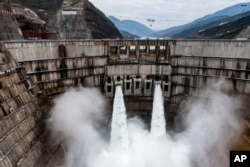
[ad_1]
Cambodia’s massive Tonle Sap Lake and its surrounding communities are currently facing multiple threats: climate change, upstream dams and ravages from illegal fishing.
The three years from 2019 to 2021 were the driest on record. The Tonle Sap’s vital flood pulse—which, due in part to the reversal of the Tonle Sap River, can expand to five times its dry-season width—appears to be disappearing, taking the lake’s rich fish stocks with it.
In the past two years, increased rainfall has brought the lake’s rainy season back to normal and even reversed Tonle Sap’s flow — good news for environmentalists and fishing communities. But experts and officials told VOA Khmer over the past two months that any temporary relief will be offset by the long-term impacts of the lake’s crisis.
“The new normal is uncertainty,” said Brian Eyler, director of the Southeast Asia and Energy, Water and Sustainability Programs at the Stimson Center.
“I think this is the new normal. The predictability of the traditional expansion that happens almost every rainy season or every monsoon season cannot be relied upon. The ability of the Tonle Sap to expand, the extent of the expansion, the sources of the expansion, and the quality of the material that flows into the lake is likely to be unique every year, given the impact of the dams and the variability of the weather.”
According to the Stimson Mekong Dam Monitoring Project, total flows to the Tonle Sap have been close to normal for the past two years. However, in 2022, due to heavy rainfall, most of the flows came in late in the rainy season, meaning the Tonle Sap missed out on early inflows that carry sediments, larvae and nutrients that are critical to annual fish stocks.
Last year’s monthly flows were nearly in line with historical averages, and it was a good fishing season, according to the Stimson Research Center in Washington, D.C.
“So the fishery is doing OK. I wouldn’t say it’s adequate or impressive, but you know, there’s a connection between the quality of the expansion and the amount of fish that’s been caught, and so far you can still see that connection working,” Eyler said in a Zoom interview in January.
“Right now, the ecosystem of the Mekong River seems to be in such a state that if expansion can get close to normal levels, the fishery will return to normal, not as it was before, but it’s still there. It’s not completely gone.”
The Tonle Sap is one of the world’s most productive inland fisheries and the source of most of Cambodians’ annual protein consumption, so concerns about the ecosystem’s demise have attracted international attention.
In 2020, National Geographic published a warning that “Cambodia’s largest lake is drying up” and faces an “existential threat,” which also endangers flooded forests that are vital to aquatic life and absorb more carbon than regular forests.
Journalist Abby Seiff writes in her 2022 book, The Trouble with Water, how ongoing droughts and damming of the Mekong River have altered the centuries-old social fabric of Cambodia, which is centered on the Tonle Sap Lake.
“Without the pulse, the rice fields around Tonle Sap have no water. The stagnation changes the way fish migrate and nutrients flow. What is left in the lake?” Seif asks in her book.
There are many culprits to blame for these unusually dry years and the collapse of fish stocks, including unpredictable weather caused by global warming and the corruption and collusion that allows illegal fishing to flourish, as Mr. Saiful details in his book. There are also upstream dams built in recent years to provide hydroelectric power to China, Laos and Thailand.
The Mekong Dam Monitoring Project aims to track where water flows come from, where it is blocked upstream, and how decisions made by countries affect other nearby countries.
According to its data, if water had not been diverted upstream (mainly in reservoirs in China), the total flow into Tonle Sap Lake in September would have been 12.4% higher than it is now, reaching a peak in 2023.
The data is intended to inform regional discussions on how to better manage the Mekong River, a vital resource for all of these countries. One phenomenon closely watched by researchers at the Stimson Institute is the later arrival and longer duration of the rainy season than historical averages.
“If that’s the case, and we can prove it, then there’s a case for upstream dams not to hold back water at the beginning of the rainy season, but also to hold back water at the end of the rainy season,” Alan Besister, president of Earth Eyes and co-principal investigator of the Mekong Dam Monitoring Project, said in a January interview.
Countries like China are primarily concerned about water availability during the dry season. If they avoid diverting water early in the rainy season, knowing they can store it later, that would help restore a more natural rhythm to the Tonle Sap’s flood pulse and the Tonle Sap’s reverse flow, Best said.
The Mekong River Commission (MRC) is the main regional body that brings together countries to coordinate water resources management and negotiate projects to build new dams on the Mekong and its tributaries.
The Mekong River Commission secretariat told VOA’s Khmer Service that a joint study it conducted found that reverse flow in the Tonle Sap Lake began later on average in the decade from 2010 to 2020 compared to 2000 to 2009. The commission said its member states – Cambodia, Thailand and Vietnam – are discussing the findings with non-member states China and Myanmar in various consultations, including a stakeholders’ forum in October.
However, the secretariat said in an email in February that it was too early to say what the “new normal” would look like, given recent drought events and “human activities in the basin.”
“These changes have potential positive and negative impacts on local communities that depend on the Mekong River and its tributaries, including the Tonle Sap Lake. These adverse impacts can be addressed to some extent through adaptation approaches at the local community level,” the report said, while discussions at the regional level are ongoing.
Mak Bunthoeurn, a project manager at the Cambodian NGO Forum, regularly engages with communities along the Mekong River and its tributaries in Cambodia, and part of his mission is to amplify the voices of these communities in national and regional dialogues.
He said that despite the relative increase in total traffic over the past few years, they still saw little reason for optimism.
“Over the past few years, residents in the local community have raised a lot of concerns and questions about low flow. They are not sure [about] “The future of the Mekong River, as well as the Tonle Sap Lake, remains uncertain because flow conditions remain low,” Mak Bunthoeun said in a Zoom interview in late January.
He said fisheries remain in trouble because most of the water in the Tonle Sap over the past two years has come from late-season rainstorms rather than early-season water from the Mekong River.
“Our researchers went to the community in mid-September and they were able to drive over land. Normally by August they are flooded,” said Mak Bunthoeurn, adding that villagers also noticed that water levels sometimes inexplicably rose faster than usual, leading them to wonder if an upstream dam was to blame.
This points to an issue that the Stimson Center, the NGO Forum, and other regional groups have called for — the need for more data and communication, especially from China, where decisions can have significant downstream impacts.
China appears to have diverted less water in the past two years compared with previous years, but it is unclear whether this is in response to downstream concerns or simply depends on China’s needs in a given year, which could again cause major damage in dry years when reservoirs dry up.
“It would be helpful if China could communicate more about its intentions and rationale for the reservoirs,” said Mr. Eyler of the Stimson Center. He noted that river watchers last year observed an “accordion effect,” where the Tonle Sap sometimes changed direction one day and then went back the next. He speculated that the phenomenon could be caused by large releases from Chinese dams.
“Compared with Southeast Asian countries, China lacks consistency in dam management. This leads to sudden rise and fall of water levels… and an ‘accordion effect’ in the Tonle Sap Lake. So I think China could learn from downstream countries to have a more consistent flood release pattern,” he said.
The Chinese Embassy in Washington said the “reasonable development” of the Mekong River, which China calls the Lancang, was in the overall interests of all countries that depend on the river.
“China always attaches great importance to the concerns and needs of downstream countries, maintains close communication with them, and is committed to water resources cooperation with relevant countries, such as hydrological data sharing, flood control and drought relief,” Chinese Embassy spokesman Liu Pengyu said in an email on February 26.
“Information sharing cooperation on the Lancang River has been deepened. Since November 2020, China has provided the Mekong countries and the Mekong River Commission with hydrological information on the Lancang River throughout the year, making important contributions to sharing water resources, jointly responding to flood disasters, and benefiting the people along the river,” he added.
In September, China also pledged to share real-time data on major dams with other Mekong countries by the end of 2023. However, “China has not lived up to its promise,” said Eyler of the Stimson Center.
The Mekong River Commission said it is “currently working closely with one of its dialogue partners, China, to strengthen cooperation to provide clear evidence of these impacts through the sharing of transparent data and information through joint studies.”
Mark Benthorne said some regional efforts are underway to establish “early warning systems” to monitor when upstream dams are planning large releases, but that system often fails at the local level, with Cambodian authorities either unable or unwilling to spread the word locally. He also said any data collected by the Mekong River Commission is not communicated to civil society groups in a timely manner, where it could be useful to local communities. But ultimately, he said, there is little regional players can do, other than to appeal to China.
“It’s hard to tell them to stop because this is beyond [Lower Mekong] “The same goes for governments because China is upstream so they can do whatever they want,” he said.
“I recommend that Mekong governments work together and cooperate to ensure that downstream communities do not suffer.”
[ad_2]
Source link




